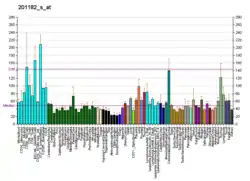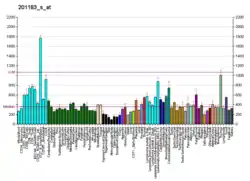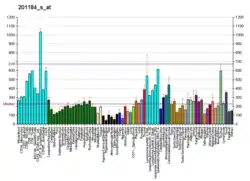CHD4
Chromodomain-helicase-DNA-binding protein 4 is an enzyme that in humans is encoded by the CHD4 gene.[5][6][7]
Function
The product of this gene belongs to the SNF2/RAD54 helicase family. It represents the main component of the nucleosome remodeling and deacetylase complex and plays an important role in epigenetic transcriptional repression. Patients with dermatomyositis develop antibodies against this protein.[7]
Interactions
CHD4 has been shown to interact with HDAC1,[8][9][10] Histone deacetylase 2,[10][11][12] MTA2,[8] SATB1[13] and Ataxia telangiectasia and Rad3 related.[12]
Clinical
Mutations in this gene have been associated with a condition known as Sifrim-Hitz-Weiss syndrome.[14] This condition is characterized by
- Brain anomalies
- Macrocephaly
- Deafness
- Ophthalmic abnormalities
- Dysmorphic features
- Congenital heart defects
- Hypogonadism in males
- Skeletal and limb anomalies
- Global developmental delay
- Mild to moderate intellectual disability
References
- GRCh38: Ensembl release 89: ENSG00000111642 - Ensembl, May 2017
- GRCm38: Ensembl release 89: ENSMUSG00000063870 - Ensembl, May 2017
- "Human PubMed Reference:". National Center for Biotechnology Information, U.S. National Library of Medicine.
- "Mouse PubMed Reference:". National Center for Biotechnology Information, U.S. National Library of Medicine.
- Seelig HP, Moosbrugger I, Ehrfeld H, Fink T, Renz M, Genth E (Oct 1995). "The major dermatomyositis-specific Mi-2 autoantigen is a presumed helicase involved in transcriptional activation". Arthritis and Rheumatism. 38 (10): 1389–99. doi:10.1002/art.1780381006. PMID 7575689.
- Seelig HP, Renz M, Targoff IN, Ge Q, Frank MB (Oct 1996). "Two forms of the major antigenic protein of the dermatomyositis-specific Mi-2 autoantigen". Arthritis and Rheumatism. 39 (10): 1769–71. doi:10.1002/art.1780391029. PMID 8843877.
- "Entrez Gene: CHD4 chromodomain helicase DNA binding protein 4".
- Yao YL, Yang WM (Oct 2003). "The metastasis-associated proteins 1 and 2 form distinct protein complexes with histone deacetylase activity". The Journal of Biological Chemistry. 278 (43): 42560–8. doi:10.1074/jbc.M302955200. PMID 12920132.
- Grozinger CM, Hassig CA, Schreiber SL (Apr 1999). "Three proteins define a class of human histone deacetylases related to yeast Hda1p". Proceedings of the National Academy of Sciences of the United States of America. 96 (9): 4868–73. doi:10.1073/pnas.96.9.4868. PMC 21783. PMID 10220385.
- Tong JK, Hassig CA, Schnitzler GR, Kingston RE, Schreiber SL (Oct 1998). "Chromatin deacetylation by an ATP-dependent nucleosome remodelling complex". Nature. 395 (6705): 917–21. doi:10.1038/27699. PMID 9804427. S2CID 4355885.
- Hakimi MA, Dong Y, Lane WS, Speicher DW, Shiekhattar R (Feb 2003). "A candidate X-linked mental retardation gene is a component of a new family of histone deacetylase-containing complexes". The Journal of Biological Chemistry. 278 (9): 7234–9. doi:10.1074/jbc.M208992200. PMID 12493763.
- Schmidt DR, Schreiber SL (Nov 1999). "Molecular association between ATR and two components of the nucleosome remodeling and deacetylating complex, HDAC2 and CHD4". Biochemistry. 38 (44): 14711–7. CiteSeerX 10.1.1.559.7745. doi:10.1021/bi991614n. PMID 10545197.
- Yasui D, Miyano M, Cai S, Varga-Weisz P, Kohwi-Shigematsu T (Oct 2002). "SATB1 targets chromatin remodelling to regulate genes over long distances". Nature. 419 (6907): 641–5. doi:10.1038/nature01084. PMID 12374985. S2CID 25822700.
- Weiss K, Lazar HP, Kurolap A, Martinez AF, Paperna T, Cohen L, Smeland MF, Wallen S, Solveig H, Keren B, Terhal P, Irving M, Takaku M, Roberts JD, Petrovich RM, Schrier Vergano SA11,12, Kenney A11, Hove H13, DeChene E, Quinonez SC, Colin E, Ziegler A, Rumple M, Jain M, Monteil D, Roeder ER, Nugent K, van Haeringen A, Gambello M, Santani A, Medne L, Krock B, Skraban CM, Zackai EH, Dubbs HA, Smol T, Ghoumid J, Parker M, Wright M, Turnpenny P, Clayton-Smith J, Metcalfe K, Kurumizaka H, Gelb BD, Baris Feldman H, Campeau PM34, Muenke M5, Wade PA, Lachlan K (2019) The CHD4-related syndrome: a comprehensive investigation of the clinical spectrum, genotype-phenotype correlations, and molecular basis. Genet Med
External links
- Human CHD4 genome location and CHD4 gene details page in the UCSC Genome Browser.
Further reading
- Denslow SA, Wade PA (Aug 2007). "The human Mi-2/NuRD complex and gene regulation". Oncogene. 26 (37): 5433–8. doi:10.1038/sj.onc.1210611. PMID 17694084.
- Ge Q, Nilasena DS, O'Brien CA, Frank MB, Targoff IN (Oct 1995). "Molecular analysis of a major antigenic region of the 240-kD protein of Mi-2 autoantigen". The Journal of Clinical Investigation. 96 (4): 1730–7. doi:10.1172/JCI118218. PMC 185809. PMID 7560064.
- Woodage T, Basrai MA, Baxevanis AD, Hieter P, Collins FS (Oct 1997). "Characterization of the CHD family of proteins". Proceedings of the National Academy of Sciences of the United States of America. 94 (21): 11472–7. doi:10.1073/pnas.94.21.11472. PMC 23509. PMID 9326634.
- Zhang Y, LeRoy G, Seelig HP, Lane WS, Reinberg D (Oct 1998). "The dermatomyositis-specific autoantigen Mi2 is a component of a complex containing histone deacetylase and nucleosome remodeling activities". Cell. 95 (2): 279–89. doi:10.1016/S0092-8674(00)81758-4. PMID 9790534. S2CID 18786866.
- Tong JK, Hassig CA, Schnitzler GR, Kingston RE, Schreiber SL (Oct 1998). "Chromatin deacetylation by an ATP-dependent nucleosome remodelling complex". Nature. 395 (6705): 917–21. doi:10.1038/27699. PMID 9804427. S2CID 4355885.
- Zhang Y, Ng HH, Erdjument-Bromage H, Tempst P, Bird A, Reinberg D (Aug 1999). "Analysis of the NuRD subunits reveals a histone deacetylase core complex and a connection with DNA methylation". Genes & Development. 13 (15): 1924–35. doi:10.1101/gad.13.15.1924. PMC 316920. PMID 10444591.
- Schmidt DR, Schreiber SL (Nov 1999). "Molecular association between ATR and two components of the nucleosome remodeling and deacetylating complex, HDAC2 and CHD4". Biochemistry. 38 (44): 14711–7. CiteSeerX 10.1.1.559.7745. doi:10.1021/bi991614n. PMID 10545197.
- Humphrey GW, Wang Y, Russanova VR, Hirai T, Qin J, Nakatani Y, Howard BH (Mar 2001). "Stable histone deacetylase complexes distinguished by the presence of SANT domain proteins CoREST/kiaa0071 and Mta-L1". The Journal of Biological Chemistry. 276 (9): 6817–24. doi:10.1074/jbc.M007372200. PMID 11102443.
- Andersen JS, Lyon CE, Fox AH, Leung AK, Lam YW, Steen H, Mann M, Lamond AI (Jan 2002). "Directed proteomic analysis of the human nucleolus". Current Biology. 12 (1): 1–11. doi:10.1016/S0960-9822(01)00650-9. PMID 11790298. S2CID 14132033.
- Koipally J, Georgopoulos K (Aug 2002). "A molecular dissection of the repression circuitry of Ikaros". The Journal of Biological Chemistry. 277 (31): 27697–705. doi:10.1074/jbc.M201694200. PMID 12015313.
- Saito M, Ishikawa F (Sep 2002). "The mCpG-binding domain of human MBD3 does not bind to mCpG but interacts with NuRD/Mi2 components HDAC1 and MTA2". The Journal of Biological Chemistry. 277 (38): 35434–9. doi:10.1074/jbc.M203455200. PMID 12124384.
- Hakimi MA, Dong Y, Lane WS, Speicher DW, Shiekhattar R (Feb 2003). "A candidate X-linked mental retardation gene is a component of a new family of histone deacetylase-containing complexes". The Journal of Biological Chemistry. 278 (9): 7234–9. doi:10.1074/jbc.M208992200. PMID 12493763.
- Kwan AH, Gell DA, Verger A, Crossley M, Matthews JM, Mackay JP (Jul 2003). "Engineering a protein scaffold from a PHD finger". Structure. 11 (7): 803–13. doi:10.1016/S0969-2126(03)00122-9. PMID 12842043.
- Shimono Y, Murakami H, Kawai K, Wade PA, Shimokata K, Takahashi M (Dec 2003). "Mi-2 beta associates with BRG1 and RET finger protein at the distinct regions with transcriptional activating and repressing abilities". The Journal of Biological Chemistry. 278 (51): 51638–45. doi:10.1074/jbc.M309198200. PMID 14530259.
- Williams CJ, Naito T, Arco PG, Seavitt JR, Cashman SM, De Souza B, Qi X, Keables P, Von Andrian UH, Georgopoulos K (Jun 2004). "The chromatin remodeler Mi-2beta is required for CD4 expression and T cell development". Immunity. 20 (6): 719–33. doi:10.1016/j.immuni.2004.05.005. PMID 15189737.
- Lehner B, Sanderson CM (Jul 2004). "A protein interaction framework for human mRNA degradation". Genome Research. 14 (7): 1315–23. doi:10.1101/gr.2122004. PMC 442147. PMID 15231747.
This article is issued from Wikipedia. The text is licensed under Creative Commons - Attribution - Sharealike. Additional terms may apply for the media files.







